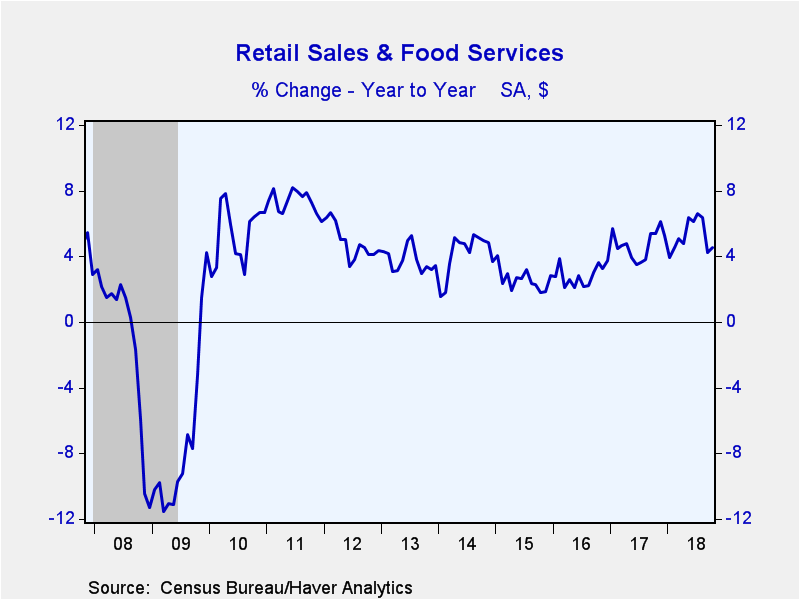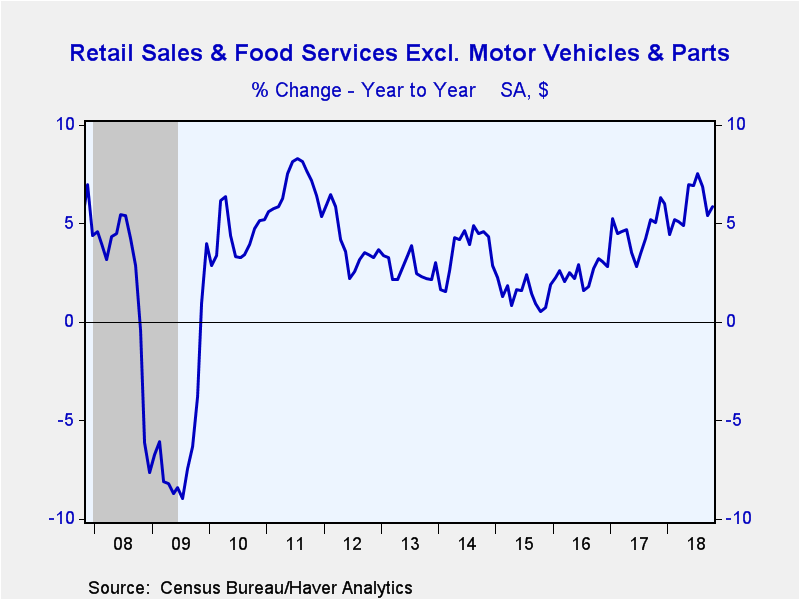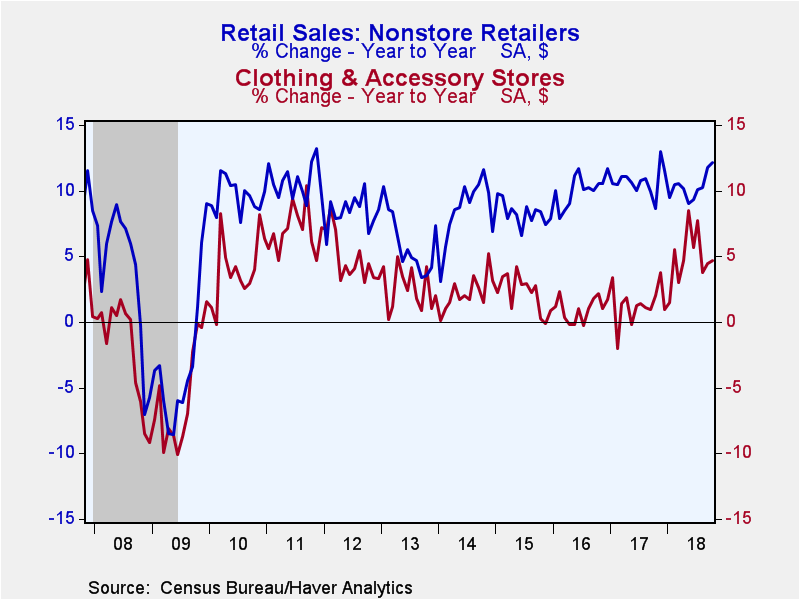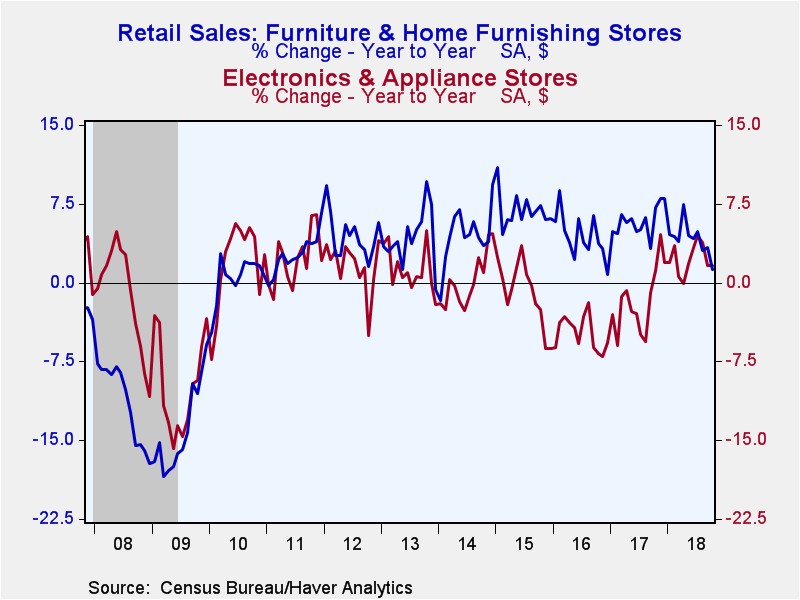 Global| Nov 15 2018
Global| Nov 15 2018U.S. Retail Sales Increase Firmly
by:Tom Moeller
|in:Economy in Brief
Summary
Total retail sales rose 0.8% (4.6% y/y) during October following two months of 0.1% decline, revised from slight increases. A 0.5% rise had been expected in the Action Economics Forecast Survey. Excluding motor vehicles and parts, [...]
Total retail sales rose 0.8% (4.6% y/y) during October following two months of 0.1% decline, revised from slight increases. A 0.5% rise had been expected in the Action Economics Forecast Survey. Excluding motor vehicles and parts, retail sales increased 0.7% after an unrevised 0.1% fall. A 0.5% improvement had been expected. A measure of the underlying pace of retail spending is nonauto sales growth excluding gasoline and building materials. These sales rose 0.3% in October (4.5% y/y), the same as in September.
Patterns amongst sales categories were mostly strong. Motor vehicle and parts dealer sales increased 1.1% (-0.3% y/y), reflecting a 0.7% rise in unit vehicle sales. Building materials & garden equipment stores gained 1.0% (3.6% y/y) following a 0.1% uptick. Purchases at electronics & appliance stores rebounded 0.7% (1.6% y/y) after a 1.5% decline. General merchandise store sales gained 0.5% (3.5% y/y) after stability in September. Sporting goods, hobby shop, book & music store sales also improved 0.5% (-8.5% y/y) following six straight months of sharp decline. Purchases at nonstore retailers rose 0.4% (12.1% y/y) after a 1.3% rise.
Gasoline service station sales jumped 3.5% (16.2% y/y) with the increase in prices. The rise followed a 0.4% easing.
Weakening by 0.3% (+1.2% y/y) were sales of furniture & home furnishings stores, down for two months in the last three.
Sales of nondiscretionary items were mixed last month. Food & beverages store sales gained 0.3% (3.0% y/y) after a 0.4% rise. Health & personal care product store sales held steady (1.8% y/y) after two months of modest decline.
Weakness in sales last month occurred in purchases at restaurant & drinking establishments with a 0.2% fall (+6.2% y/y), off for the third straight month.
The retail sales data can be found in Haver's USECON database. The Action Economics forecast is in the AS1REPNA database.
What Does Labor Market Tightness Tell Us About the End of an Expansion? from the Federal Reserve Bank of Chicago is available here.
| Retail Spending (% chg) | Oct | Sep | Aug | Oct Y/Y | 2017 | 2016 | 2015 |
|---|---|---|---|---|---|---|---|
| Total Retail Sales & Food Services | 0.8 | -0.1 | -0.1 | 4.6 | 4.3 | 3.1 | 2.6 |
| Excluding Autos | 0.7 | -0.1 | 0.1 | 5.9 | 4.3 | 2.7 | 1.4 |
| Retail Sales | 0.9 | 0.2 | -0.1 | 4.3 | 4.5 | 2.8 | 1.9 |
| Motor Vehicle & Parts | 1.1 | -0.1 | -0.7 | -0.3 | 4.3 | 4.6 | 7.2 |
| Retail Less Autos | 0.8 | 0.2 | 0.1 | 5.8 | 4.5 | 2.2 | 0.4 |
| Gasoline Stations | 3.5 | -0.4 | 1.6 | 16.2 | 8.8 | -5.7 | -17.6 |
| Food Service & Drinking Places Sales | -0.2 | -1.5 | -0.1 | 6.2 | 2.7 | 5.6 | 8.2 |
Tom Moeller
AuthorMore in Author Profile »Prior to joining Haver Analytics in 2000, Mr. Moeller worked as the Economist at Chancellor Capital Management from 1985 to 1999. There, he developed comprehensive economic forecasts and interpreted economic data for equity and fixed income portfolio managers. Also at Chancellor, Mr. Moeller worked as an equity analyst and was responsible for researching and rating companies in the economically sensitive automobile and housing industries for investment in Chancellor’s equity portfolio. Prior to joining Chancellor, Mr. Moeller was an Economist at Citibank from 1979 to 1984. He also analyzed pricing behavior in the metals industry for the Council on Wage and Price Stability in Washington, D.C. In 1999, Mr. Moeller received the award for most accurate forecast from the Forecasters' Club of New York. From 1990 to 1992 he was President of the New York Association for Business Economists. Mr. Moeller earned an M.B.A. in Finance from Fordham University, where he graduated in 1987. He holds a Bachelor of Arts in Economics from George Washington University.










